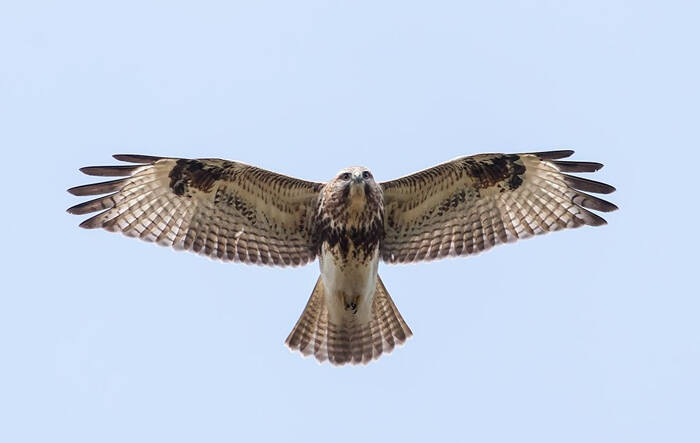Buteo japonicus
IUCN
LCBasic Information
Scientific classification
- name:Buteo japonicus
- Scientific Name:Buteo japonicus,Eastern Buzzard,Japanese buzzard, East Asian buzzard
- Outline:Raptor
- Family:Accipitridae Buteo
Vital signs
- length:42-54cm
- Weight:515-970g
- lifetime:20-70years
Feature
Once a subspecies of the Eurasian buzzard (Buteo buteo), it was classified as a separate species in 2014.
Distribution and Habitat
Origin: China, India, Japan, North Korea, Mongolia, Nepal, Pakistan and Russia.
Breeding: Northern Mariana Islands, Russia (East Asia).
Non-breeding: Bangladesh, Bhutan, Cambodia, China (Hong Kong and Taiwan Province), South Korea, Laos, Myanmar, Sri Lanka, Thailand and Vietnam.
Wandering (non-breeding): Brunei, Indonesia, Malaysia, Maldives, Philippines and Singapore.
Uncertain origin (uncertain seasonality): Palau.
During the breeding period, it mainly inhabits mountain forests and forest edges. It is distributed from sea level to at least 1,300 meters of foothill broad-leaved forests, to 2,000 meters of mixed forests and coniferous forests, and sometimes even appears above the mountaintop tundra belt above 2,000 meters above sea level. In autumn and winter, it mostly appears in low mountains, hills and foothill plains.
Appearance
The body length is 42–54 cm, the wingspan is 122–137 cm, the male weighs 630–810 g, and the female weighs 515–970 g. The upper body is dark reddish brown; the skin on the side of the face is yellow with almost red fine lines, and the chestnut mustache pattern is obvious; the lower body is mainly dark brown or light brown, with dark brown horizontal spots or vertical stripes, and the tail feathers are light grayish brown with multiple dark lines. Horizontal spots, the wings are broad when flying, there are obvious white spots at the base of the primary flight feathers, the underwings are flesh-colored, only the wing tips, wing angles and outer edges of the flight feathers are black (light type) or all are dark brown (dark type) , the tail feathers fan out. When soaring at high altitude, the wings form a slight "V" shape. In addition, the position of its nostrils is parallel to the rostrum, while the nostrils of other buzzards are at an oblique angle to the rostrum. The iris is
Details
Common buzzard is a medium-sized bird of prey with three subspecies.

Common buzzards are lighter and have fewer feathers on their tibia than Eurasian buzzards. The body feathers are noticeably redder and the head is usually whiter. The white feathers on the chest have black stripes, and the abdomen and thighs are often stained brown. The tail is dark gray-brown with more or less stripes.
Common buzzards are often seen hovering and soaring over open plains, deserts, wilderness, cultivated farming areas, forest edge grasslands and villages. They often move alone, and sometimes 2-4 are seen hovering in the sky. They are mainly active during the day. They are alert and have sharp vision. They are good at flying, and spend most of the day hovering and gliding in the air, with their broad wings spread out to the left and right, and slightly raised up to form a shallow "V" shape, and their short and round tail spread out in a "fan" shape, with an extremely graceful posture.
The common buzzard mainly hunts by circling in the air, observing and searching with its sharp eyes. Once it finds prey on the ground, it suddenly dives down quickly and grabs it with its claws. In addition, it also perches on high places such as branches or telephone poles to wait for prey, and only pounces when the prey appears in front of it. It feeds on forest rodents and has a large appetite. In addition to rodents, it also eats animal food such as frogs, lizards, snakes, hares, small birds and large insects. Sometimes it also goes to villages to hunt chickens and other poultry.
The breeding season of the common buzzard is from April to July. It usually nests on the edge of the forest or on tall trees in the forest, especially coniferous pine trees. It usually nests on branches near the main trunk in the upper part of the tree canopy, 6-20 meters above the ground. Some nest in caves of overhanging rocks or on steep slopes or cliffs. The nest structure is relatively simple, mainly made of dead branches, padded with pine needles, twigs and dead leaves, and sometimes feathers and animal hair. The size of the nest is 60-90 cm in outer diameter, 20-30 cm in inner diameter, 40-60 cm in height and 10 cm in depth. Eggs are laid in May-June, with 2-4 eggs per nest. The eggs are bluish-white with chestnut brown and purple-brown spots and stripes, and are 50-61 mm × 41-48 mm in size. After the first egg is laid, incubation begins, which is undertaken by both male and female parents, with the female being the main one, and the incubation period is about 28 days. The chicks mature late, and are fed by both male and female parents after hatching. The competition among the chicks in the nest is very fierce, and the survival rate is 35%. After 30-33 days of nesting, the chicks can fly and leave the nest.
Given the split caused by the species reclassification and delineation since 2015, the global population size of the common buzzard is unknown. No population information is available for the nominated species, but the Oshima and Idome subspecies are considered rare. Trend justification: Population trends are difficult to determine due to uncertainty about the impact of habitat modification on population size.
Listed in the IUCN Red List of Threatened Species 2016 ver3.1 - Least Concern (LC).
Listed in Appendix I, II and III of the Convention on International Trade in Endangered Species of Wild Fauna and Flora (CITES) 2019 edition Appendix II.
Listed in China's "National Key Protected Wildlife List" (February 5, 2021) Level 2.
Protect wildlife and eliminate game.
Maintaining ecological balance is everyone's responsibility!








